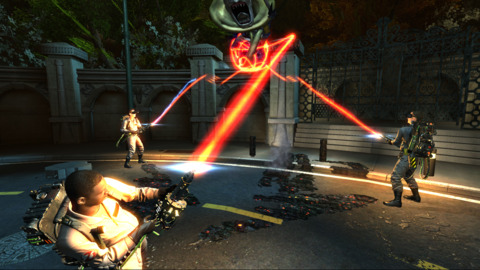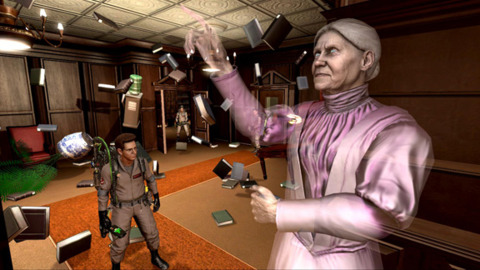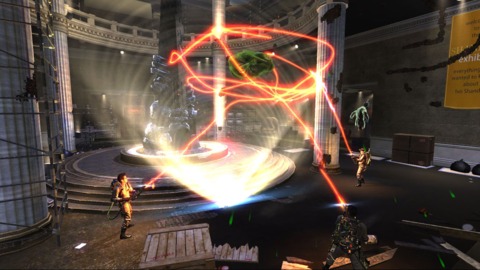Ghostbusters: The Video Game Review

Taking place a few years after the events of Ghostbusters II, Ghostbusters: The Video Game puts you in the role of a nameless, mute new recruit who's been brought on as an "Experimental Equipment Technician," which is another way of saying "your proton pack has all kinds of new tricks." Right off the bat, you're hanging in the firehouse with the boys, listening to Janine take bizarre calls, striking up conversations with Vigo the Carpathian, and generally just soaking in the rich ectoplasmic atmosphere. Once the game kicks in, you'll go on a whirlwind tour of memorable Ghostbusters faces and places, starting off with the recapturing of Slimer at the Sedgwick Hotel, moving to Times Square to face the Stay-Puft Marshmallow Man, and then on to the main branch of the New York Public Library to finally bring in the silence-loving Grey Lady. The story even does a fairly admirable job of tying it all back into a story about Gozer the Gozerian. For the first few hours, I honestly found all the loving fan service intoxicating. Even the new characters and locations seemed to mesh well.

The process of trapping a ghost is an involved one, and in Ghostbusters: The Video Game, a terrific-looking one, as well. The way your energy beam chaotically twists around your targets and blows apart any unfortunate objects that might get in your path, and the way a ghost will stretch out and try to claw its way away from the trap look as good as it ever did in the movies. The characters look uncannily like 19-year-younger versions of the actors playing them, though there's something about the way they animate, particularly during cutscenes, that feels cartoony in a way that doesn't quite match the characters or the voice work.
The gameplay is reliant on the basic act of busting ghosts and the familiar hardware associated with it. There are a lot of lesser spooks that will evaporate if you hammer on them long enough, but you'll also spend a lot of time going through the full capture process, wearing down ghosts and wrangling them into a trap. You start off with a basic neutrino wand and ghost trap setup, but as the story progresses, you'll be granted upgrades that allow you to shoot more concussive blasts of energy, "freeze" ghosts with a stasis beam, neutralize toxic black slime with your positively charged slime blower, and more. Some of your proton pack's abilities--specifically the capture beam and the slime tether--let you play with the game's physics, allowing you to engage in some occasional light puzzle work. You'll earn money for every ghost you take out, which you can put towards various upgrades, but for as regularly as the game introduces new toys for you to play with, I didn't feel like the core of the gameplay really changed that much from the beginning to the end, and it all feels a little bit sloppy. I won't deny that it's unique amongst third-person shooters, but even still, what was exciting the first few times eventually felt rote to me.

Perhaps most baffling to me about my experience with Ghostbusters: The Video Game is, as problematic as I found the single-player experience, how much I found myself enjoying the multiplayer. This online mode consists of six different four-player co-op "job" types, which you can attack one at a time, or in a few different three-level mini-campaigns. It's mostly just variants on arena-based multiplayer modes you're probably already familiar with, but the unique tools of the Ghostbusters put an interesting twist on them, and there's some good persistence with the money you earn and a "most wanted" list of ghosts to hunt down to keep you coming back. Some modified weapon behavior aside, it doesn't really handle much differently from the single-player, but the pacing is tighter and playing with live teammates is far more gratifying. This, no doubt, is a point that will irritate PC players, as that version of Ghostbusters: The Video Game features none of the multiplayer action found in the PS3 and Xbox 360 versions.
Ghostbusters: The Video Game is nothing if not enthusiastic for the source material, which will undoubtedly be enough for some to have a good time. It certainly kept me going for a good while, but nostalgia alone couldn't quite carry the whole experience. This is one of the pitfalls of something as recognizable as Ghostbusters. It comes with a built-in audience, but that audience can come with some high expectations.
